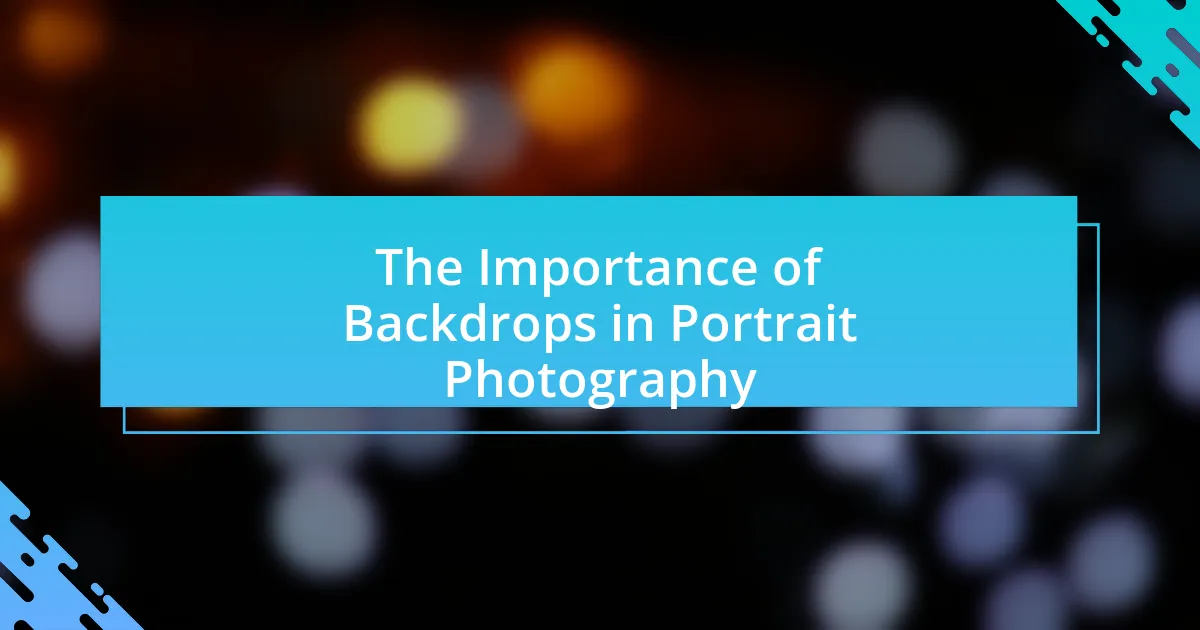Lens filters are optical devices used in portrait photography to modify light entering the camera, significantly impacting the final image quality. This article explores the various types of lens filters, including polarizing, neutral density, and UV filters, and their specific effects on color saturation, contrast, and sharpness in portrait images. It discusses how these filters enhance skin tones, reduce glare, and allow for creative control over exposure and depth of field. Additionally, the article addresses potential drawbacks of using filters, such as reduced image quality and unwanted artifacts, while providing best practices for their effective use in portrait photography.

What are Lens Filters and How Do They Affect Portrait Images?
Lens filters are optical devices placed in front of a camera lens to modify the light entering the camera, affecting the final image. In portrait photography, lens filters can enhance colors, reduce glare, and soften skin tones, contributing to a more aesthetically pleasing image. For example, a polarizing filter can reduce reflections and increase color saturation, making skin tones appear more vibrant. Additionally, diffusion filters can create a soft focus effect, which is often desirable in portraiture to minimize blemishes and create a flattering look. These effects are supported by the fact that many professional photographers utilize filters to achieve specific artistic outcomes in their work.
What types of lens filters are commonly used in portrait photography?
Commonly used lens filters in portrait photography include polarizing filters, neutral density filters, and UV filters. Polarizing filters reduce glare and enhance color saturation, making skin tones appear more vibrant. Neutral density filters allow for longer exposure times without overexposing the image, which can create a softer background blur. UV filters protect the lens from dust and scratches while having minimal impact on image quality. These filters are essential tools for photographers aiming to improve the quality and aesthetic of portrait images.
How does a polarizing filter enhance portrait images?
A polarizing filter enhances portrait images by reducing reflections and glare, which results in clearer and more vibrant colors. This filter works by blocking certain light waves, allowing for improved contrast and saturation in the subject’s features. For instance, when photographing a person outdoors, the polarizing filter can minimize reflections from water or shiny surfaces, making skin tones appear more natural and enhancing the overall image quality. Additionally, studies have shown that using a polarizing filter can increase color saturation by up to 30%, making the portrait more visually appealing.
What role does a neutral density filter play in portrait photography?
A neutral density filter reduces the amount of light entering the camera lens, allowing photographers to use wider apertures or slower shutter speeds in bright conditions. This capability is crucial in portrait photography, as it enables the creation of a shallow depth of field, which helps to isolate the subject from the background and achieve a pleasing bokeh effect. By controlling exposure without affecting color balance, neutral density filters enhance the overall aesthetic of portrait images, making them more visually appealing.
How do lens filters influence the quality of light in portrait images?
Lens filters significantly influence the quality of light in portrait images by altering the characteristics of the light that reaches the camera sensor. For instance, polarizing filters reduce reflections and enhance color saturation, resulting in more vibrant skin tones and clearer details. Additionally, neutral density filters allow for longer exposure times without overexposing the image, enabling photographers to create a shallow depth of field that beautifully blurs the background while keeping the subject in sharp focus. These adjustments lead to improved contrast and clarity, which are essential for capturing the nuances of a subject’s features.
What is the impact of lens filters on color saturation in portraits?
Lens filters can significantly enhance color saturation in portraits by selectively modifying the light that reaches the camera sensor. For instance, polarizing filters reduce reflections and glare, allowing for deeper blues in the sky and more vibrant colors in foliage, which can lead to a more saturated overall image. Additionally, color filters, such as warming or cooling filters, can shift the color balance, enhancing specific hues and increasing the perceived saturation of skin tones. Studies have shown that using these filters can result in a more visually appealing portrait, as they help to emphasize the subject’s features and create a more dynamic image.
How do lens filters affect contrast and sharpness in portrait images?
Lens filters can significantly enhance contrast and sharpness in portrait images by controlling light and reducing glare. For instance, polarizing filters minimize reflections and increase color saturation, which can lead to more vivid and defined portraits. Additionally, neutral density filters allow for longer exposure times without overexposing the image, enabling better depth of field and sharper details in the subject. Studies have shown that the use of specific filters can improve perceived sharpness by reducing lens aberrations and enhancing edge definition, thus contributing to a more professional and polished look in portrait photography.

Why Should Photographers Use Lens Filters for Portraits?
Photographers should use lens filters for portraits to enhance image quality and control lighting conditions. Specifically, polarizing filters reduce glare and reflections, allowing for richer colors and improved contrast in skin tones. Additionally, neutral density filters enable photographers to use wider apertures or slower shutter speeds in bright conditions, creating a pleasing depth of field or motion blur effect. Studies have shown that using these filters can significantly improve the overall aesthetic of portrait images, making them more visually appealing and professional.
What are the advantages of using lens filters in portrait photography?
Using lens filters in portrait photography enhances image quality and creative control. Specifically, polarizing filters reduce glare and reflections, allowing for richer colors and improved contrast, which is crucial for skin tones. Neutral density filters enable longer exposure times, facilitating creative effects like motion blur in backgrounds while keeping the subject sharp. Additionally, UV filters protect the lens from scratches and dust, ensuring clarity in images. These advantages collectively contribute to producing more visually appealing and technically sound portraits.
How do lens filters help in achieving specific artistic effects?
Lens filters assist in achieving specific artistic effects by modifying light before it reaches the camera sensor. For instance, polarizing filters reduce reflections and enhance color saturation, resulting in more vivid images, particularly in landscapes and portraits. Additionally, neutral density filters allow for longer exposure times, enabling creative motion blur effects or shallow depth of field in bright conditions. These filters can also create unique color casts or softening effects, contributing to the overall mood and style of the portrait. The use of these filters is supported by photographic practices that demonstrate their effectiveness in enhancing visual storytelling and artistic expression.
What practical benefits do lens filters provide during outdoor portrait shoots?
Lens filters provide several practical benefits during outdoor portrait shoots, including glare reduction, improved color saturation, and enhanced contrast. Glare reduction is achieved through polarizing filters, which minimize reflections from surfaces like water or glass, allowing for clearer skin tones and details in the subject. Improved color saturation occurs with the use of UV filters or polarizers, which can make colors appear more vibrant and true to life, enhancing the overall aesthetic of the portrait. Additionally, lens filters can enhance contrast by reducing haze and increasing the clarity of the image, resulting in sharper and more defined portraits. These benefits collectively contribute to higher-quality outdoor portrait photography.
What are the potential drawbacks of using lens filters in portrait photography?
Using lens filters in portrait photography can introduce several potential drawbacks, including reduced image quality, increased lens flare, and altered color balance. Reduced image quality occurs because filters can add additional glass elements that may degrade sharpness and contrast, particularly if the filter is of low quality. Increased lens flare can result from reflections between the filter and the lens, which can distract from the subject. Additionally, filters may alter color balance, leading to unwanted color casts that require correction in post-processing. These factors can negatively impact the overall aesthetic and technical quality of portrait images.
How can lens filters introduce unwanted artifacts in portrait images?
Lens filters can introduce unwanted artifacts in portrait images by causing issues such as color casts, reduced sharpness, and flare. Color casts occur when filters alter the color balance of the image, leading to unnatural skin tones. Reduced sharpness is often a result of lower-quality filters that degrade image clarity, impacting the overall detail in the portrait. Flare can happen when light reflects off the filter’s surface, creating unwanted light spots or haze that distract from the subject. These artifacts can significantly detract from the quality of portrait photography, making it essential for photographers to choose high-quality filters and understand their potential effects.
What considerations should photographers keep in mind when choosing lens filters?
Photographers should consider the type of lens filter that best suits their specific needs, including the filter’s purpose, quality, and compatibility with their lens. The purpose of the filter, such as UV protection, polarizing effects, or neutral density, directly influences the choice, as each serves a different function in image capture. Quality is crucial; high-quality filters minimize optical distortion and maintain image clarity, while lower-quality filters can introduce unwanted artifacts. Compatibility with the lens is also essential, as filters must fit the lens diameter and mount securely to avoid vignetting or other issues. For instance, using a polarizing filter can enhance color saturation and reduce reflections, which is particularly beneficial in portrait photography.

How Can Photographers Effectively Use Lens Filters in Portrait Photography?
Photographers can effectively use lens filters in portrait photography by selecting the appropriate filter type to enhance image quality and control lighting. For instance, a polarizing filter reduces glare and reflections, allowing for richer colors and improved contrast, which is particularly beneficial in outdoor settings. Additionally, neutral density filters enable photographers to use wider apertures in bright conditions, creating a shallow depth of field that isolates the subject from the background. Research indicates that using these filters can significantly improve the overall aesthetic of portrait images by enhancing clarity and color saturation.
What techniques can enhance the use of lens filters in portrait photography?
Using lens filters effectively in portrait photography can be enhanced through techniques such as selecting the appropriate filter type, adjusting exposure settings, and utilizing creative compositions. For instance, a polarizing filter can reduce glare and enhance colors, making skin tones appear more vibrant. Additionally, using a neutral density filter allows for wider apertures in bright conditions, enabling a shallow depth of field that isolates the subject. Furthermore, experimenting with filter placement and angle can create unique effects, such as softening harsh light or adding a warm tone to the image. These techniques are supported by the fact that filters can manipulate light in ways that enhance the overall aesthetic of portrait images, as evidenced by numerous professional photographers who incorporate filters into their workflow for improved results.
How can photographers combine multiple filters for creative effects?
Photographers can combine multiple filters by stacking them on the lens to achieve unique visual effects. For instance, using a polarizing filter alongside a neutral density filter can enhance color saturation while controlling exposure, allowing for creative manipulation of light and shadow in portrait images. This technique is supported by the fact that polarizing filters reduce glare and reflections, while neutral density filters enable longer exposure times without overexposing the image, thus providing photographers with greater control over their artistic vision.
What tips can help in selecting the right filter for specific portrait scenarios?
To select the right filter for specific portrait scenarios, consider the lighting conditions and desired effects. For instance, a polarizing filter reduces glare and enhances colors, making it ideal for outdoor portraits in bright sunlight. Conversely, a neutral density filter allows for longer exposure times, which can create motion blur in dynamic scenes, suitable for capturing movement in portraits. Additionally, using a soft focus filter can soften skin textures, providing a flattering effect for close-up portraits. These filters are commonly used in professional photography to achieve specific artistic outcomes, demonstrating their effectiveness in enhancing portrait images.
What are common mistakes to avoid when using lens filters in portraits?
Common mistakes to avoid when using lens filters in portraits include using the wrong type of filter, which can lead to undesirable effects such as color casts or loss of sharpness. For instance, using a polarizing filter without understanding its impact on reflections can result in uneven lighting on the subject’s face. Additionally, neglecting to check for vignetting, especially with wide-angle lenses, can cause dark corners in the image, detracting from the overall quality. Furthermore, failing to clean filters properly can introduce dust or smudges that compromise image clarity. Lastly, over-relying on filters instead of mastering lighting techniques can limit a photographer’s creative options and lead to subpar results.
How can improper filter use affect the final portrait image quality?
Improper filter use can significantly degrade the final portrait image quality by introducing unwanted artifacts, altering color accuracy, and reducing sharpness. For instance, using a polarizing filter incorrectly can lead to uneven lighting and color saturation, resulting in unnatural skin tones. Additionally, using a low-quality filter can introduce lens flare and distortion, which detracts from the overall clarity and detail of the portrait. Studies have shown that filters can affect light transmission and image contrast, emphasizing the importance of selecting the right filter for the desired effect.
What best practices should photographers follow when using lens filters?
Photographers should ensure they use high-quality lens filters to maintain image clarity and color accuracy. High-quality filters minimize the risk of introducing unwanted artifacts or distortions, which can negatively affect portrait images. Additionally, photographers should regularly clean their filters to prevent dust and smudges from impacting image quality. Using the correct filter type for specific conditions, such as polarizing filters to reduce glare or ND filters for controlling exposure, is essential for achieving desired effects in portrait photography. Finally, photographers should avoid stacking multiple filters, as this can lead to vignetting and reduced image sharpness.
What are the best lens filters for achieving stunning portrait images?
The best lens filters for achieving stunning portrait images are polarizing filters and neutral density filters. Polarizing filters enhance color saturation and reduce reflections, which can improve the overall quality of portrait images by making skin tones appear more vibrant and reducing glare from shiny surfaces. Neutral density filters allow for greater control over exposure without affecting color balance, enabling photographers to use wider apertures for a shallow depth of field, which is ideal for isolating subjects against blurred backgrounds. These filters are widely recognized in photography for their ability to enhance image quality and are commonly used by professional portrait photographers.
















